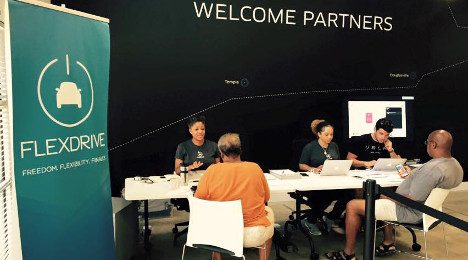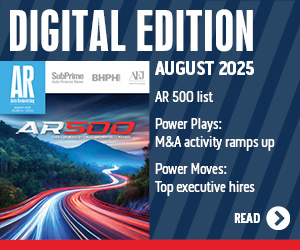More details of Cox’s Flexdrive involvement with Uber

Officials from Uber and Flexdrive work with potential clients during an event on July 28 in Dallas. (Photo from Flextime's Facebook page)
The co-founder and general manager of one of Cox Automotive’s newest enterprises — Flexdrive — emphasized during a phone conversation with Auto Remarketing on Tuesday that ramping up its rental fleet numbers and relationship with Uber — the online transportation service provider that’s grown in popularity in some of the largest U.S. metro areas — isn’t eventually going to result in another retail competitor against dealers.
Jose Puente explained that Flexdrive’s involvement with Uber is mostly geared to remove a “friction point for Uber’s growth.” That point comes when drivers are interested in becoming part of the Uber network of providers but would rather not commit to a new-vehicle purchase if they don’t already possess a model that qualifies within Uber’s program.
Uber explained in a report Auto Remarketing posted last week that some drivers want to rent a vehicle when and where they’d like to drive, instead of leasing or buying one. As a result, Uber is working with Flexdrive to pilot a weekly rental option in Atlanta, Dallas, and Nashville, Tenn.
Puente also mentioned the pilot program is expanding into Austin, Texas, beginning on Sept. 3.
Flexdrive already has about 1,000 units in its fleet associated with the Uber program with plans to add “considerably more for 2016,” depending the demand from the transportation provider.
The current plan is for that cluster of vehicles to be in the Uber fleet for about 30 months or 100,000 miles, whichever point arrives first. And Puente indicated that those vehicles would end up in the wholesale market, not through a retail endeavor some rental companies employ.
“We’ve got a variety of options. Our intention is never to retail any cars directly to consumers,” Puente said. “We’re not going to create a new type of car dealership model.
“What we’re looking at is monetizing the use of the car over a period of time and then disposing of that car through the auction to dealers who might be interested in our cars,” he continued.
For dealers not typically interested in vehicles with six figures on the odometer, they might change their mind because of how Flexdrive intends to maintain these units.
A consumer’s relationship with Flexdrive includes vehicle maintenance, roadside assistance and insurance. The company intends to contact the driver every 90 days or 6,000 miles. At that point, the consumer either swaps vehicles or takes the unit in for service at an authorized center where a 190-point inspection and other maintenance tasks are to be completed.
“Effectively what happens as you’re driving the car, we’re monitoring what’s going on with the car,” Puente said.
“The consumer doesn’t have to do anything other than put gas in it and keep it clean,” he added.
Flexdrive’s terms of use includes a breakdown of fees if the vehicle need special attention such as being cleaned of smoke or pet remnants.
“Drive as if it was your own car,” Flexdrive said on its website. “While Flexdrive maintains insurance on all fleet cars available in carriers, through the services, you will be responsible for all uncovered damages, costs, and deductibles resulting from your use of the fleet car, and for all damages that result from a breach of these terms of use or your membership agreement.”
Currently a wide array of popular models already are in Flexdrive’s fleet, including:
— Hyundai Accent, Elantra and Sonata
— Nissan Versa, Sentra, Altima and Pathfinder
— Toyota Corolla, Camry and Highlander
— Chevrolet Cruze
Puente noted that hybrid vehicles are in the fleet, too, but not all-electric models because of their charge limitations that might hinder Uber drivers. He also mentioned that Flextime isn’t involved with Uber’s business that includes limousines or other commercial vehicles.
“We have people who are driving full time, meaning they’re driving over 40 hours a week,” Puente said. “We have people who are driving less than that. A lot of people are driving just enough to cover their car payment.”
Puente added that Flexdrive’s program with Uber officially launched back in May, but the relationship between the two companies started more than a year earlier.
“We started the idea of Flexdrive based on the micro-trends going on in the marketplace based on car-sharing and ride-sharing trends and the needs of people to have alternatives to ownership,” Puente said.
“In the process of putting it together, and arranging our pilot program, we started talking with a lot of people in the industry, car-sharing companies to see what their experiences have been,” he continued. “Through that, we ended up meeting with Uber. They expressed some of the challenges they had with respect to getting people signed up not have the proper car to drive on Uber.
“It wasn’t planned. We just kind of crossed paths at about the same time,” Puente went on to say.


